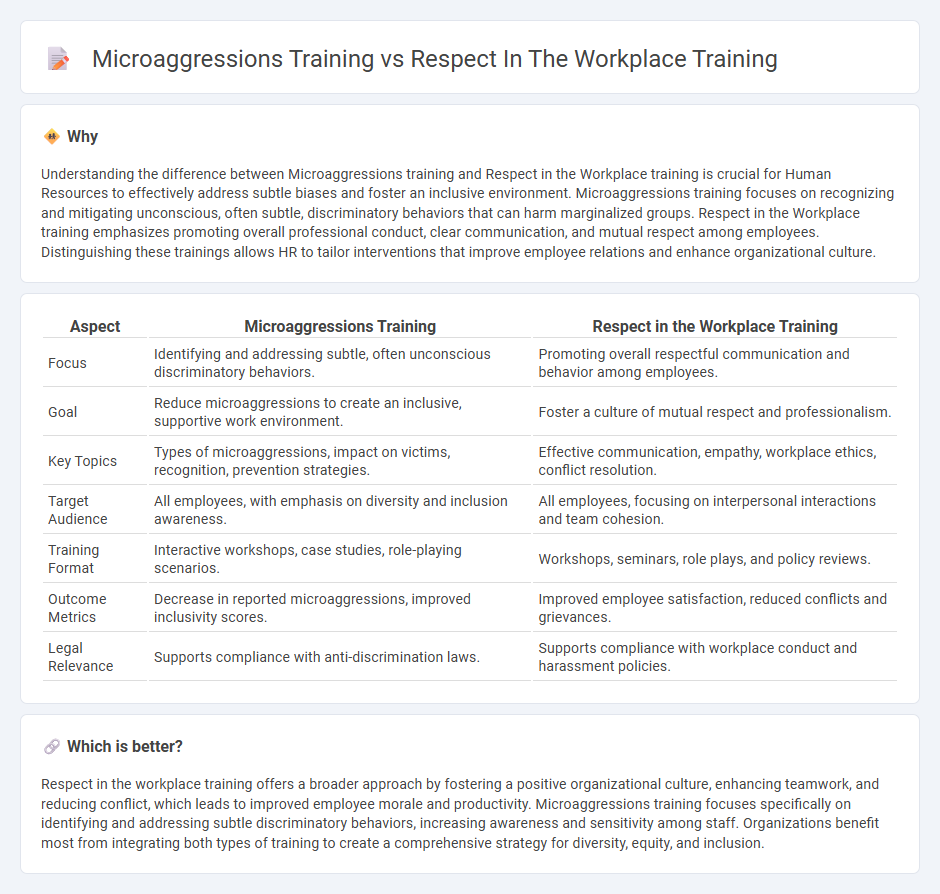
Microaggressions training focuses on identifying and addressing subtle, often unintentional discriminatory comments or behaviors that can harm workplace inclusivity, while Respect in the Workplace training emphasizes fostering a culture of mutual respect, professionalism, and positive interpersonal interactions. Both trainings aim to improve employee relations and create a supportive work environment that enhances productivity and reduces conflicts. Explore how these programs can transform your organizational culture and promote a healthier, more respectful workplace.
Why it is important
Understanding the difference between Microaggressions training and Respect in the Workplace training is crucial for Human Resources to effectively address subtle biases and foster an inclusive environment. Microaggressions training focuses on recognizing and mitigating unconscious, often subtle, discriminatory behaviors that can harm marginalized groups. Respect in the Workplace training emphasizes promoting overall professional conduct, clear communication, and mutual respect among employees. Distinguishing these trainings allows HR to tailor interventions that improve employee relations and enhance organizational culture.
Comparison Table
| Aspect | Microaggressions Training | Respect in the Workplace Training |
|---|---|---|
| Focus | Identifying and addressing subtle, often unconscious discriminatory behaviors. | Promoting overall respectful communication and behavior among employees. |
| Goal | Reduce microaggressions to create an inclusive, supportive work environment. | Foster a culture of mutual respect and professionalism. |
| Key Topics | Types of microaggressions, impact on victims, recognition, prevention strategies. | Effective communication, empathy, workplace ethics, conflict resolution. |
| Target Audience | All employees, with emphasis on diversity and inclusion awareness. | All employees, focusing on interpersonal interactions and team cohesion. |
| Training Format | Interactive workshops, case studies, role-playing scenarios. | Workshops, seminars, role plays, and policy reviews. |
| Outcome Metrics | Decrease in reported microaggressions, improved inclusivity scores. | Improved employee satisfaction, reduced conflicts and grievances. |
| Legal Relevance | Supports compliance with anti-discrimination laws. | Supports compliance with workplace conduct and harassment policies. |
Which is better?
Respect in the workplace training offers a broader approach by fostering a positive organizational culture, enhancing teamwork, and reducing conflict, which leads to improved employee morale and productivity. Microaggressions training focuses specifically on identifying and addressing subtle discriminatory behaviors, increasing awareness and sensitivity among staff. Organizations benefit most from integrating both types of training to create a comprehensive strategy for diversity, equity, and inclusion.
Connection
Microaggressions training and Respect in the workplace training are interconnected by promoting awareness of subtle discriminatory behaviors and fostering a culture of inclusivity and psychological safety. Both trainings equip employees with skills to recognize and address unconscious biases, enhancing communication and reducing workplace conflict. Implementing these programs contributes to higher employee engagement, retention, and overall organizational performance.
Key Terms
**Respect in the workplace training:**
Respect in the workplace training emphasizes fostering a positive, inclusive environment by promoting mutual understanding, effective communication, and recognizing diverse perspectives. This training focuses on building professional relationships, preventing conflicts, and enhancing collaboration through empathy and ethical behavior. Explore more ways respect training can transform your organizational culture and improve employee satisfaction.
Professionalism
Respect in the workplace training emphasizes cultivating professionalism by fostering mutual understanding, clear communication, and ethical behavior to create a positive and inclusive environment. Microaggressions training targets identifying and addressing subtle, often unconscious, discriminatory comments or actions that undermine professional respect and contribute to a hostile work atmosphere. Explore how integrating both trainings enhances professionalism and workplace harmony for further insights.
Inclusive Communication
Respect in the workplace training emphasizes building a culture of mutual regard and professional boundaries, while microaggressions training targets identifying and addressing subtle, often unintentional, discriminatory behaviors. Both approaches are vital for fostering inclusive communication by promoting empathy, awareness, and effective dialogue among diverse teams. Explore tailored strategies and best practices to enhance your organization's inclusive communication efforts.
Source and External Links
RESPECT in the Workplace Video Course - This program educates managers and supervisors on building a respectful workplace environment, focusing on respect and acceptable workplace conduct rather than just legal compliance.
Respect in the Workplace Training Course - This online course covers topics like bullying, harassment, and workplace culture, offering a CPD-accredited certificate upon completion.
Respect in the Workplace For Employees eLearning - This 40-minute eLearning course provides tools to create and maintain a respectful organization, focusing on employee accountability and behavior.
 dowidth.com
dowidth.com